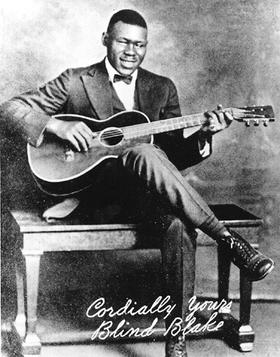Blind Blake: A Biography
Introduction
Arthur Blake (1896 – December 1, 1934), known as Blind Blake, was an influential American blues and ragtime singer and guitarist. He is celebrated for his intricate fingerpicking style, which significantly impacted the development of Piedmont blues and inspired numerous musicians across various genres. His recordings for Paramount Records between 1926 and 1932 established him as one of the most accomplished guitarists of his era.

Childhood
Little is definitively known about Blind Blake’s early life. Promotional materials from Paramount Records suggested he was born blind in Jacksonville, Florida. However, later research, particularly by Alex van der Tuuk and his colleagues in 2011, indicates that his 1934 death certificate states he was born in 1896 in Newport News, Virginia, to Winter and Alice Blake. Despite these differing accounts, it is believed he spent periods of his life in Jacksonville and may have had relatives in Patterson, Georgia. Some theories even link him to the Geechee (Gullah) dialect, suggesting a connection to the Sea Islands. Nothing else is known of Blake’s early years until he emerged as a recording musician in the 1920s.
Youth and Adulthood: The Rise of a Ragtime Blues King
Blind Blake’s career as a recording artist began in 1926, primarily with Paramount Records. He quickly became their best-selling artist, recording an impressive 79 known sides under his own name and contributing as an accompanist to other notable artists like Gus Cannon, Papa Charlie Jackson, Irene Scruggs, Ma Rainey, and Ida Cox. His prolific output and distinctive sound earned him the moniker “King Of The Ragtime Guitar.”
Blake’s guitar playing was characterized by an intricate, syncopated fingerpicking style, often compared to ragtime piano. He is widely considered the primary developer of this “finger-style” ragtime on the guitar, a technique that few have been able to match since. His early recordings, such as “Early Morning Blues” and “West Coast Blues,” are considered prototypes for the burgeoning Piedmont blues style.
Despite his significant impact and popularity, much of Blind Blake’s personal life remains shrouded in mystery. Information outside of his recordings is largely based on conjecture and rumor. While a theory once suggested his true name was Arthur Phelps, Blake himself stated his name as Arthur Blake on his 1929 recording “Blind Arthur’s Breakdown.” Interviews with musicians who knew him personally reveal little beyond his fondness for liquor.
Major Compositions and Musical Legacy
Blind Blake’s discography is rich with classic early blues performances. Some of his most notable compositions include “Early Morning Blues,” “Too Tight,” “Skeedle Loo Doo Blues,” “That Will Never Happen No More,” “Southern Rag,” “Diddie Wa Diddie,” “Police Dog Blues,” “Playing Policy Blues,” and “Righteous Blues.” Many of his original tunes have become country-blues standards, and his influence on the Atlanta-based Piedmont blues scene was formidable, even if primarily through his recordings. His sincerity, gentle humor, and effortless execution of complex fingerwork continue to astonish listeners.
Death
Blind Blake’s recording career ended with Paramount Records’ bankruptcy in 1932. The circumstances surrounding his death are as enigmatic as his early life. While a story circulated that he was murdered in Chicago shortly after his last Paramount session, this has not been substantiated by police records. The most widely accepted theory is that he returned to Jacksonville, Florida, and died a few years later, with 1937 being a suggested date. However, a 2011 investigation by Alex van der Tuuk, Guido van Rijn, and others, based on his death certificate, confirmed that Arthur Blake died on December 1, 1934, in Milwaukee, Wisconsin, from pulmonary tuberculosis. He was buried in an unmarked grave in Milwaukee’s Glen Oaks Cemetery.
Conclusion
Blind Blake remains one of the most significant and influential figures in early American blues and ragtime. Despite the scarcity of verifiable biographical details, his musical legacy endures. His innovative guitar playing and timeless compositions continue to inspire new generations of musicians, solidifying his place as a true master of the ragtime blues guitar. His contributions to the development of blues music are undeniable, and his recordings stand as a testament to his extraordinary talent.

Comments are closed